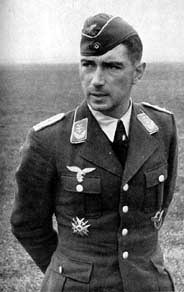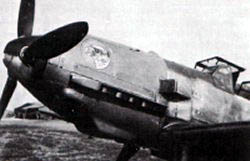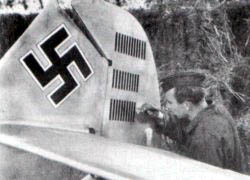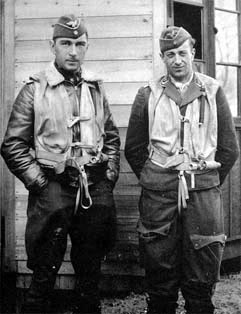


Werner "Vati" Mölders was born on 18 March 1913, at Gelsenkirchen in the Ruhrgebiet. He was set to become the role model for all young German fighter pilots. Molders had been intent on a career in the Military after his Father was killed in the First World War, he entered the Dresden Military Academy in 1932 and would graduate two years later. In 1934 he applied for flight training with the Luftwaffe passing all but one test, the centrifugal spin chair which made him dizzy and caused him to vomit, a doctor was to recommend that Molders was unfit to become a pilot. Molders was determined though and practiced with the chair until he passed. Flying sickness though would continue with Molders during the early part of his career. He was badly afflicted by air sickness but overcame the problem through sheer willpower. On 1 July 1935, Leutnant Mölders was posted to Fliegergruppe Schwerin (later to be redesignated I./StG 162). He was appointed Staffelkapitän of 1./JG 334 (later to be redesignated 1./JG 53) on 15 March 1936. On 1 April 1936, he was transferred to the Schulstaffel of JG 134 to undertake instructing duties. For two years he was an instructor at Wiesbaden. He volunteered for the Condor Legion and arrived by sea in Cadiz on 14 April that year. 1938 3 Staffel of JG 88 needed a new leader to replace Adolf Galland in Spain and Molders was chosen, after one month under the watch of Galland, Molders was accepted. It was here in Spain with the Condor Legion that Molders scored his first victory a polikarpov I -16 fighter, it was also in Spain that Molders would help every new pilot under his command to score their first victory and to help them through the experience. By the 31st of October Molders had scored 14 victories in Spain and he returned to Germany in early November as the highest scoring pilot of the Condor Legion.

Molders Messerschmitt during the Battle Of Britain.
During the Spanish conflict he showed considerable qualities not only as a pilot and marksman but also, and especially, as a tactician and organizer. Werner would spend the winter teaching Luftwaffe recruits his tactics that he had learned while in Spain. Together with other airmen, in Spain he developed the technique known as the "finger four", or fan, which improved a flight's all-round vision and encouraged the pilots' initiative. Between 15 July and 3 November 1938, he shot down fourteen aircraft: eleven I-16 "Mosca", two Polikarpov I-15 "Chato" and one SB-2 "Katyuska", as well as one unconfirmed I-16 victory, most of these at the controls of the Bf 109 C-1 coded 6-79 "Luchs". He was awarded the Spanienkreuz in Gold mit Schwertern und Brillanten in recognition of his achievements. At the end of the year he returned to Germany as the highest scoring German pilot of the Spanish conflict, with a glowing reputation and a maturity beyond his years and rank. At the beginning of World War II, Mölders was Staffelkapitän of 1./JG 53 "Pik As", based at Wiesbaden-Erbenheim. He became known by those under his command as "Vati" (Daddy) Mölders. He shot down his first aircraft of the Second World War on 21 September 1939, a French Curtiss 75 A fighter. On 1 November he went on to command III./JG 53, also based at Wiesbaden-Erbenheim. On 27 May 1940, after his 20th victory, a French Curtiss 75 A SW of Amiens, he was promoted to Hauptmann and decorated with the Knight's Cross. He was shot down in combat on 5 June 1940, by French ace Sous Lieutenant René Pommier Layragues (6 victories) flying a D.520 of GC II/7 after having scored 25 victories during 128 missions and was taken prisoner. He was liberated two weeks later upon the armistice with France.

Molders opened his World War II account by scoring in the opening weeks of the French campaign when he shot down a Curtis Hawk on the 20th of September 1940, by May he had become the first Luftwaffe pilot to reach 20 victories and was awarded the Ritterkreuz. Molders scoring tactic was to hit them hard from close range. It was here in France that Molders was to became a POW, while leading 15 Messerschmitts on a patrol Molders messerschmitt was raked with shells, shattering his canopy and setting the engine on fire Molders bailed out and floated to earth where he was captured by French troops, life as a POW was short though as France surrendered a few weeks later.
He returned to Germany to be promoted to Major and given command of JG 51 as Kommodore. On 28 July 1940, during his first flight with his new unit, he succeeded in downing a Spitfire, but his aircraft was then hit by the enemy aircraft.
 Severely wounded in the legs, Mölders just managed to make an emergency landing at the airfield at Wissant in France. It was not until a month later that he was able to return to combat, most likely flying the Bf 109 E-4 W.Nr. 2404 (photographed on 31 August with 32 victory bars), as well as W.Nr. 3737, (shot down over England while being flown by Hptm Asmus on 25 October, with no stab markings according to the crash report, but 49 victory bars). He quickly brought his score up by downing 28 British fighters during the remainder of the Battle of Britain, including his 40th, a Spitfire over Dungeness, on 20 September, for which he was awarded the Oak Leaves (No. 2) the next day. On 22 October he downed three RAF Hurricanes to become the first Luftwaffe pilot to reach a score of 50 aerial victories. By the end of the Battle of Britain he had a total of 54 victories, and he would add one more before the end of the year.
By the 26th of February Molders was Germany's second highest scoring Ace with 68 victories behind him. By June of 1941 Molders was in the East, and JG 51 would became the first Luftwaffe fighter group to reach the 1,000 victories mark, on another day in June JG 51 shot down 96 Soviet aircraft and Molders accounted for 11 of those, by the end of July Molders had 115 victories to his name. Realizing that Molders was too valuable to risk in combat the higher powers in the Luftwaffe decided to ground him and at the age of just 28 he became Inspecteur der Jagdflieger (Inspector of Fighters). He was constantly on the move, wherever he was required Molders would be creating and directing battle groups of Stukas and fighters. It was around this time that Molders received notice of Ernst Udet's suicide and he requested to be one of the guard of honours at the funeral, despite very bad weather Molders took a flight in a Heinkel HE III Bomber, the plane took off in a violent thunderstorm despite pleas from the pilot to turn back Molders insisted that the flight continued. The weather was only to worsen with powerful headwinds, as the flight neared Breslau one of the engines failed, as the aircraft approached the landing strip the second engine failed, the Heinkel slammed into the ground killing Molders’ instantly. It is said that the entire nation mourned Molders passing, Jg 51 was awarded the name Molders. Werner Molders finished the War with 115 victories.
Severely wounded in the legs, Mölders just managed to make an emergency landing at the airfield at Wissant in France. It was not until a month later that he was able to return to combat, most likely flying the Bf 109 E-4 W.Nr. 2404 (photographed on 31 August with 32 victory bars), as well as W.Nr. 3737, (shot down over England while being flown by Hptm Asmus on 25 October, with no stab markings according to the crash report, but 49 victory bars). He quickly brought his score up by downing 28 British fighters during the remainder of the Battle of Britain, including his 40th, a Spitfire over Dungeness, on 20 September, for which he was awarded the Oak Leaves (No. 2) the next day. On 22 October he downed three RAF Hurricanes to become the first Luftwaffe pilot to reach a score of 50 aerial victories. By the end of the Battle of Britain he had a total of 54 victories, and he would add one more before the end of the year.
By the 26th of February Molders was Germany's second highest scoring Ace with 68 victories behind him. By June of 1941 Molders was in the East, and JG 51 would became the first Luftwaffe fighter group to reach the 1,000 victories mark, on another day in June JG 51 shot down 96 Soviet aircraft and Molders accounted for 11 of those, by the end of July Molders had 115 victories to his name. Realizing that Molders was too valuable to risk in combat the higher powers in the Luftwaffe decided to ground him and at the age of just 28 he became Inspecteur der Jagdflieger (Inspector of Fighters). He was constantly on the move, wherever he was required Molders would be creating and directing battle groups of Stukas and fighters. It was around this time that Molders received notice of Ernst Udet's suicide and he requested to be one of the guard of honours at the funeral, despite very bad weather Molders took a flight in a Heinkel HE III Bomber, the plane took off in a violent thunderstorm despite pleas from the pilot to turn back Molders insisted that the flight continued. The weather was only to worsen with powerful headwinds, as the flight neared Breslau one of the engines failed, as the aircraft approached the landing strip the second engine failed, the Heinkel slammed into the ground killing Molders’ instantly. It is said that the entire nation mourned Molders passing, Jg 51 was awarded the name Molders. Werner Molders finished the War with 115 victories.